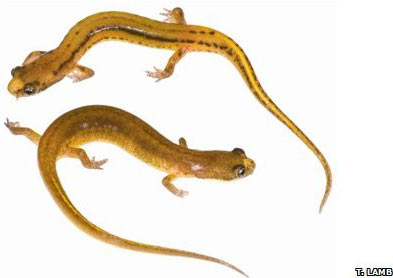Discovered strange salamanders in America
Scientists have found non-lung salamanders in a small stream in the American Appalachian Mountains. They have many differences compared to the salamander species that people know.
New salamander species are not classified into any of the salamanders we know. They breathe through the skin and are called Urspelerpes brucei or " mottled salamander " due to the yellow markings on the nose. Their average length is 25-26 cm.
" In the last 50 years there have not been any vertebrate or four-legged amphibians found in the US. So this is a surprising discovery for us ," biologist Carlos Camp Piedmont University's speech.
Worldwide there are nearly 500 salamander species, of which 2/3 do not have lungs and respiration through holes in wet skin. The Appalachian plateau in the southeastern United States is home to many non-lung salamanders. They live in humid or high humidity places such as streams, cliffs, trees, fallen leaves in the forest, underground caves.

Males have two black stripes running along the body, while females do not have black stripes.(Photo: National Geographic)
" The salamander species in the US in general and the Appalachian plateau in particular have been thoroughly studied and continuously studied for more than a century. Therefore, the discovery of a completely new species is something that nobody expected ", Camp explains. prefer.
Spotted salamanders are smaller in size than all known salamanders in the United States . They are also the only non-lung salamanders that males have different colors and patterns of females - a trait that is unique to birds. Male individuals have yellow backs and two dark stripes running along the body. The yellow on the female body is lighter and they do not have dark stripes. Males have 15 vertebrae while females have 16 vertebrae.
Male and female individuals of most non-lung salamanders have different sizes, but they are similar in size to the mottled salamander species. They have 5 toes, while most other salamanders have only 4 toes. Behaviors and lifestyles of spotting are still a mystery. The structure of teeth and jaws shows that they catch small animals, like insects, with a tongue that is able to release out like other non-lung salamanders.
Camp's group found 8 mature mottled salamanders. They all live in small streams. 4 children hiding behind the rocks and 4 others under the leaf layer. 3 are female and all have eggs.

- Video: Discovering the strange giant salamander in Japan
- The salamander has 8 tails
- Salamanders 'fish'
- 8 strange creatures seem like they do not belong to this planet
- Discovering the principle of regenerating the body of salamanders
- America appeared strange fish from the sky
- Mexican salamanders: the broken leg grows, the heart breaks, but is still rescued but is about to become extinct
- Spotted spiders have strange legs in America
- Humans can 'grow back and forth' like reptiles
- Lizard and salamanders: hear with ... lungs
- Why can't humans replicate hearts like newts?
- Use mucus from salmon skin to make surgical glue
 Animal 'suffering' after hibernation
Animal 'suffering' after hibernation Why do goats climb well?
Why do goats climb well? Scientists were surprised to see chimpanzees eating turtles
Scientists were surprised to see chimpanzees eating turtles Giant catfish died deadly due to drought in Thailand
Giant catfish died deadly due to drought in Thailand